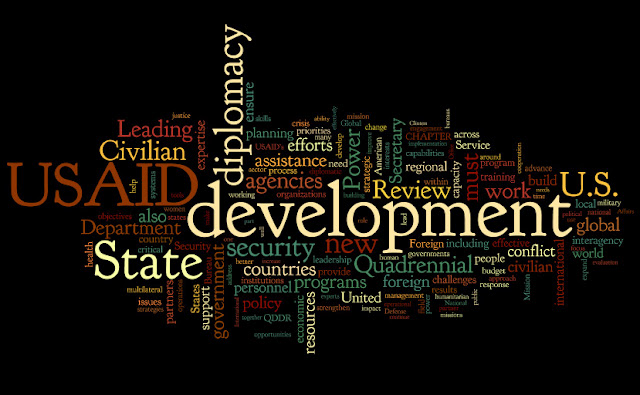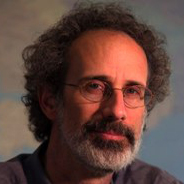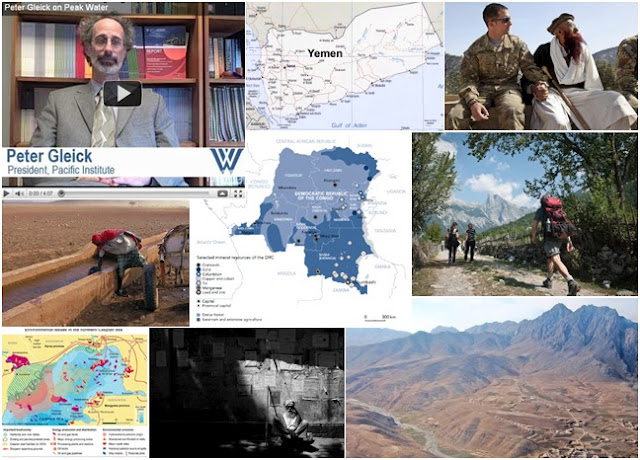-
Women and Youth in 21st Century Statecraft
January 10, 2011 // By Richard CincottaMOREWhether one supports or finds fault with current (and envisioned) U.S. diplomacy and international development processes and practices, most foreign policy analysts and academics will recognize the first Quadrennial Diplomatic and Development Review (QDDR) as a landmark document. In my opinion, the QDDR – titled Leading Through Civilian Power – is essential reading for those who seek a career in government or who otherwise need to understand the nature and purpose of the work that foreign service officers and USAID missions perform overseas.
Topics: development, funding, gender, Middle East, QDDR, Reading the QDDR, security, South Asia, State, youth -
Beat on the Ground
Watch: Annie Wallace on Connecting PHE Approaches With Climate and Poverty
“It’s really important to link the integrated PHE approach with the policies and strategies of the country,” says Annie Wallace, who worked as a PHE technical advisor with USAID’s Global Health Fellows Program in Ethiopia. “Because if you don’t have political buy-in from the decision-makers and the leaders, then it’s going to be really difficult to justify the allocation of different funds for these projects to be expanded to other regions, or expanded in scale, or even to expand outside of the country.”MORE
With Ethiopia in particular, Wallace stressed the importance of PHE practitioners connecting their integrated approach with how it will help address the country’s poverty alleviation and climate change adaptation strategies. “The prime minister is a leader in Africa talking about climate change,” Wallace said, “and we really need to talk about how an integrated approach can help with adaptation and reducing a community’s vulnerability to climate change.”
On the funders’ side, Wallace noted that as monitoring and evaluation becomes more important, donors also need to be able to support building capacity in organizations in order to meet the new requirements. During her work with The David and Lucile Packard Foundation (via USAID), Wallace helped set up the PHE Ethiopia Consortium to facilitate such capacity-building efforts. -
Beat on the Ground
Abdalah Overcomes the Odds
MOREThis PHE Champion profile was produced by the BALANCED Project.
“Now, people can plan their families and know how to use a condom,” says Abdalah Masingano as he proudly tells how his community has come to accept integrated population, health, and environment (PHE) activities.
The 35 year-old Abdalah is a PHE provider. He lives near the Saadani National Park (SANAPA) — one of Tanzania’s newest, and the only terrestrial park with a contiguous marine area in southeastern Tanzania. Saadani is home to the rare Roosevelt Sable antelope and the nesting grounds for several endangered species of marine turtles. One of the largest threats to biodiversity in this area is the clearing of mangroves and coastal forests for firewood and charcoal-making. About 95 percent of households in the area depend on firewood for cooking and most use a three-stone fireplace that utilizes only about 10 percent of its energy potential. These are just some of many pressures that people living around the park place on the biodiversity-rich forest and marine resources of the area.
Abdalah and his 31 year-old wife have two children: a 14-year-old boy and a six-year-old girl. His wife has been on the pill for four years. For two years now, Abdalah has been selling condoms in his village store. He made this decision for simple reasons. He saw that people needed condoms for both family planning and health, and he had come to understand the linkages between the behaviors of people living in the area and the health of the environment.
Abdalah gained this understanding when he was recruited to become a PHE provider by the Tanzania Coastal Management Partnership as part of its work through the USAID-supported BALANCED Project, which is promoting PHE implementation in biodiversity-rich countries. In a two-day training, Abdalah learned about integrated PHE and the links between population (family planning), health, and the environment. He has been educating villagers ever since.
“In the past, it was difficult for people to plan their families because they were embarrassed,” recalls Abdalah. As a PHE provider, Abdalah delivers integrated PHE messages to his fellow villagers. After attending the BALANCED training, Abdalah learned that promoting family planning makes sense for reasons beyond health. Forest and marine resources found both around and inside the Saadani are heavily exploited by local villages – and from a biodiversity conservation perspective, reducing population pressures is just one critical step in protecting this biodiversity.
When people visit his shop, Abdalah takes the opportunity to explain the population and environment connection. Because deforestation is a particular problem in the area where Abdalah lives and works, he promotes the use of fuel-efficient stoves.
Showcasing his own stove, his explains that by using a simple clay stove – which is made locally – a household can save almost 1.5 tons of fuelwood annually and reduce by 50 percent the time women spend collecting fuelwood. At the same time, he reminds villagers that when they plan their families they help keep mothers and children healthy. Healthier families also tend to put fewer pressures on – and thus keep healthier – the very natural resources they depend on for food and income.
Initially, Abdalah’s Muslim neighbors were unhappy with him promoting family planning and condom use. They believed what he was doing encouraged sex and prostitution. “They thought I was lost,” he explains smiling. Fortunately, his wife has been very supportive of him despite the discouraging reactions of his fellow villagers early on in his efforts.
Today, Abdalah’s perseverance has paid off. He now sells more than 200 condoms monthly and takes the time to demonstrate to his customers how to use them properly. When there is the opportunity, he also refers his customers to the local health dispensaries for additional family planning services and commodities. Abdalah believes people respect him now. “I feel good because I am able to help,” he concludes. That “help” impacts both the health and well-being of his fellow villagers and the health and well-being of the environment. Abdalah and his wife plan to have their third child two years from now.
This PHE Champion profile was produced by the BALANCED Project. A PDF version can be downloaded from the PHE Toolkit. PHE Champion profiles highlight people working on the ground to improve health and conservation in areas where biodiversity is critically endangered.
Sources: Darfur Stoves Project, IPS News, TSN Daily News, UN.
Photo Credit: Abdalah showing a box of condoms for sale in his small shop by Juma Dyegula, courtesy of the BALANCED Project. -
Friday Podcasts
Peter Gleick on Peak Water
MORE “The purpose of the whole debate about peak water is to help raise awareness about the nature of the world’s water problems and to help drive toward solutions,” says the Pacific Institute’s Peter Gleick. But Gleick asserts that in the same way certain countries have been contending with “peak oil” concerns in recent years, they may soon also have to deal with “peak water” as well.
“The purpose of the whole debate about peak water is to help raise awareness about the nature of the world’s water problems and to help drive toward solutions,” says the Pacific Institute’s Peter Gleick. But Gleick asserts that in the same way certain countries have been contending with “peak oil” concerns in recent years, they may soon also have to deal with “peak water” as well.
Unlike oil, water is largely a renewable resource, but countries in Asia, the Middle East, and elsewhere are pumping groundwater faster than aquifers can replenish naturally. Gleick explains “there will be a peak of production in many of those places and eventually the food that we grow with that water or the widgets that we make from the factories that use that water will be nonsustainable and production will have to drop.”
The world’s surface and groundwater resources can be used sustainably even in the face of continued global population growth, says Gleick, but only “if we are careful about the ecological consequences and the efficiency with which we use it.” However, to date, he says, “those issues have not adequately been brought into the discussion about water policy.”
The “Pop Audio” series is also available as podcasts on iTunes. -
From the Wilson Center
Gender-Based Violence in the DRC
MOREIn the Democratic Republic of the Congo (DRC), “armed conflict has resulted in mass displacement and widespread sexual violence; the problem is that it hasn’t always been quantified,” said Dr. Lynn Lawry, senior health stability and humanitarian assistance specialist at the U.S. Department of Defense. Presenting findings from the first cross-sectional, randomized cluster study on gender-based violence in the DRC, Lawry was joined at the Wilson Center by Heidi Lehmann, director of the Gender-based Violence Unit at the International Rescue Committee, and Dr. Nancy Glass, associate professor at the Johns Hopkins School of Nursing and associate director at the Johns Hopkins Center for Global Health. “We found that sexual violence in these areas is conflict-related, prevalent, systematic, and widespread,” said Lawry. [Video Below]
Study Finds “Female Perpetrators”
The first of its kind in the region, the population-based, quantitative study covers three districts in the DRC and a total of 5.2 million adults. It comprehensively assesses gender-based violence, including its prevalence, circumstances, perpetrators, and physical and mental health impacts.
Overall, the study found that 2.1 million women and 1.3 million men in the region had suffered sexual violence. Nearly three-quarters of all sexual violence reported was a direct result of conflict. In the study region, 20 percent of the population fought in conflicts, and 48 percent of these combatants were female.
Further, 39 percent of female survivors and 15 percent of male survivors reported female perpetrators. “These findings challenge the paradigm of male perpetrator and female victim,” said Lawry. “Policymakers and donors should adjust societal paradigms of sexual and gender-based violence and also direct attention to female perpetrators and male survivors.” Survivors of sexual violence in conflict, both male and female, are more at risk of later becoming perpetrators, particularly if unrecognized and untreated. To “break the cycle of violence,” prevention and response programs should address the needs of survivors and combatant perpetrators of both genders.
“Community-related violence is a general crime; conflict-related violence is a war crime,” Lawry said. While many efforts have focused on the Congolese military, she called for the DRC government and the International Criminal Court to also investigate and prosecute members of rebel groups, who were found to be the main perpetrators of sexual violence and other human rights abuses in this study.
Prevention: The Best Response
“Meeting the immediate consequences of violence is not enough,” said Lehmann. To effectively address gender-based violence, programs must provide medical and social services, promote social empowerment, respond to emergencies, and take part in advocacy and coordination efforts.
In the DRC, programs supported by the International Rescue Committee serve approximately 350 to 400 survivors per month, 75 percent of whom report that the perpetrators are members of armed groups.
Scaling up is a major challenge. “Providing essential services alone require enormous investment, and there is no common understanding of comprehensive programming,” said Lehmann. “We recognize that a program alone cannot solve all of these problems, especially in the DRC.”
“Good response is about prevention,” concluded Lehmann. She recommended supporting robust, long-term programming; integrating gender-based violence prevention efforts into other sectors; and investing in partnerships. “We are not going to end the violence unless Congolese women and girls are part of the conversation.”
Pigs for Peace: A Holistic Approach
Health care, economic development, and social programs should be integrated “to provide a holistic and comprehensive approach” to the problem of gender-based violence, said Glass. “Rape destabilizes families and communities,” she said.
Survivors rarely get immediate treatment for their injuries and trauma, or the risk of HIV, STIs, and infertility. “Many rural primary health centers and hospitals have been looted of medicines and materials by rebels and soldiers,” said Glass. Conflict in the DRC has also caused health care professionals to leave unstable rural areas, and poor roads and limited transportation make it unsafe and expensive to seek care.
To rebuild families and communities, “women and men need to regain their economic resources to provide for the future of their family and community,” said Glass. Pigs for Peace, for example, has supplied more than 100 women — many of them rape survivors — and their families with pigs to set them on the path to recovery through psychological, social, and economic empowerment. This program aims not only to supplement household income, but to reduce the stigma of rape as survivors become productive parts of their families and communities.
Photo Credit: “Congo kivu,” courtesy of flickr user andré thiel. -
Eye On
‘Clear Gold’ Report From CSIS
“The real wild-card for political and social unrest in the Middle East over the next 20 years is not war, terrorism, or revolution – it is water,” begins the CSIS Middle East Program’s latest report, Clear Gold: Water as a Strategic Resource in the Middle East, by Jon B. Alterman and Michael Dziuban.MORE
The authors contend that with growing populations, groundwater depletion, not the more traditional questions about transboundary river governance, poses a “more immediate and strategically consequential challenge,” particularly because many Middle Eastern governments have deflated the true cost of water to help spur growth and garner popularity.
In the accompanying video feature above, much-troubled Yemen is outlined as one of the most at-risk countries for water-induced instability. The narrator notes that “with Yemen’s population growing fast and almost half of agricultural water going towards the narcotic leaf qat instead of food, experts think that Sanaa [the capital] could run out of water in seven years or less and the rest of the country may not be far behind.”
In an interview with Reuters in 2008, Yemeni Water and Environment Minister Abdul-Rahman al-Iryani said the country’s burgeoning water crisis is “almost inevitable because of the geography and climate of Yemen, coupled with uncontrolled population growth and very low capacity for managing resources.”
Yemen is a particularly abject example because water availability is only one contributor in a long list of domestic problems, including a large youth population, gender inequity, immigration from the Horn of Africa, corruption, ethnic tensions, and terrorism.
The narrator concludes that “Yemen is the most worrisome example but clearly not the only one.” Alterman and Dziuban also point to Jordan and Saudi Arabia as states vulnerable to groundwater depletion.
For more on the Middle East’s current and future environmental security issues, be sure to check out The New Security Beat’s “Crossroads” series, with features on Iraq, Israel, Jordan, Lebanon, Syria, and Yemen.
Video Credit: “Clear Gold: Water as a Strategic Resource in the Middle East,” courtesy of CSIS.Topics: consumption, environmental security, Eye On, Jordan, Middle East, migration, population, water, Yemen, youth -
A Crucial Connection: India’s Natural Security
January 5, 2011 // By Michael KugelmanMOREExcerpted from the original op-ed, “A Crucial Connection,” by Michael Kugelman in The Times of India:
With India’s soaring growth and rising global clout hogging media headlines, it is easy to forget the nation is beset by security challenges. Naxalite insurgency rages across more than two-thirds of India’s states, while long-simmering tensions in Jammu and Kashmir exploded once again this summer. Meanwhile, two years post-Mumbai, Pakistan remains unwilling or unable to dismantle the anti-India militant groups on its soil. Finally, China’s military rise continues unabated. As Beijing increases its activities across the Himalayan and Indian Ocean regions, fears about Chinese encirclement are rife.
It is even easier to forget that these challenges are intertwined with natural resource issues. Policy makers in New Delhi often fail to make this connection, at their own peril. Twenty-five per cent of Indians lack access to clean drinking water; about 40 per cent have no electricity. These constraints intensify security problems.
India’s immense energy needs – household and commercial – have deepened its dependence on coal, its most heavily consumed energy source. But India’s main coal reserves are located in Naxalite bastions. With energy security at stake, New Delhi has a powerful incentive to flush out insurgents. It has done so with heavy-handed shows of force that often trigger civilian casualties. Additionally, intensive coal mining has displaced locals and created toxic living conditions for those who remain. All these outcomes boost support for the insurgency.
Meanwhile, the fruits of this heavy resource extraction elude local communities, fuelling grievances that Naxalites exploit. A similar dynamic plays out in Jammu and Kashmir, where electricity-deficient residents decry the paltry proportion of power they receive from central government-owned hydroelectric companies. In both cases, resource inequities are a spark for violent anti-government fervor.
Continue reading on The Times of India.
For more on India’s Naxalite rebellion and its natural resource drivers, see The New Security Beat’s “India’s Maoists: South Asia’s ‘Other’ Insurgency.”
Michael Kugelman is program associate with the Asia Program at the Woodrow Wilson International Center for Scholars.
Photo Credit: “Mysore Coal Man,” courtesy of flickr user AdamCohn.Topics: conflict, economics, energy, environmental security, India, livelihoods, minerals, natural resources, water -
What You Are Reading
End of the Year Edition: Top 10 Posts for 2010
The New Security Beat’s 2010 top ten (measured by unique pageviews) included guest contributions from Marc Levy, Todd Walters, and the UK’s Royal Society, a post by West Point Cadet Marie Hokenson, a video feature with Peter Gleick, and posts on global enviro-security hot spots Afghanistan, India, the Democratic Republic of the Congo, and Yemen:MORE
1. Watch: Peter Gleick on Peak Water
“The concept of ‘peak water’ is very analogous to peak oil…we’re using fossil groundwater. That is, we’re pumping groundwater faster than nature naturally recharges it,” says Peter Gleick in this short expert analysis from the Environmental Change and Security Program. Gleick, president and co-founder of the Pacific Institute and author of the newest edition of The World’s Water, explains the new concept of peak water.
2. Copper in Afghanistan: Chinese Investment at Aynak
Will new investments by the Metallurgical Corporation of China (MCC) in the Aynak copper mine break Afghanistan out of its poverty trap? Will future revenues from the subsoil assets in Logar Province bring peace and stability to the ongoing conflict?
3. DRC’s Conflict Minerals: Can U.S. Law Impact the Violence?
Apple CEO Steve Jobs, in a personal email posted by Wired, recently tried to explain to a concerned iPhone customer the complexity of ensuring Apple’s devices do not use conflict minerals like those helping to fund the civil war in the Democratic Republic of Congo. However much one might be tempted to pile on Apple at the moment, Mr. Jobs is on to something with regard to the conflict minerals trade – expressing outrage and raising awareness of the problem is one thing but actually implementing an effective solution is quite another.
4. India’s Maoists: South Asia’s “Other” Insurgency
The Indian government’s battle with Maoist and tribal rebels – which affects 22 of India’s 35 states and territories, according to Foreign Policy and in 2009 killed more people than any year since 1971 – has been largely ignored in the West. That should change, as South Asia’s “other” insurgency, fomenting in the world’s largest democracy and a key U.S. partner, offers valuable lessons about the role of resource management and stable development in preventing conflict.
5. On the Beat: Climate-Security Linkages Lost in Translation
A recent news story summarizing some interesting research by Halvard Buhaug carried the headline “Civil war in Africa has no link to climate change.” This is unfortunate because there’s nothing in Buhaug’s results, which were published in the Proceedings of the National Academy of Sciences, to support that conclusion.
6. Guest Contributor Todd Walters: Imagine There’s No Countries: Conservation Beyond Borders in the Balkans
International peace parks have captured the imagination of visionaries like Nelson Mandela, who called them a “concept that can be embraced by all.” Such parks—also known as transboundary protected areas—span national boundaries, testifying to the peaceful collaborative relationship between neighboring countries and to the co-existence of humans and nature.
7. Restrepo: Inside Afghanistan’s Korengal Valley
Restrepo, the riveting new documentary film from Tim Hetherington and Sebastian Junger, follows a platoon of U.S. soldiers deployed in the dangerous Korengal Valley of Afghanistan. As a cadet at West Point majoring in human geography, I was fascinated to watch the ways the soldiers confronted and adapted to the challenges posed by the local culture of the remote Afghan community surrounding their outpost.
8. UK Royal Society: Call for Submissions: “People and the Planet” Study To Examine Population, Environment, Development Links
In the years that followed the Iranian revolution, when Ayatollah Khomeini returned from exile to Tehran and the country went to war against Iraq, the women of Iran were called upon to provide the next generation of soldiers. Following the war the country’s fertility rate fell from an average of over seven children per woman to around 1.7 children per woman – one of the fastest falls in fertility rates recorded over the last 25 years.
9. Demographics, Depleted Resources, and Al Qaeda Inflame Tensions in Yemen
A second spectacular Al Qaeda attack on Yemeni government security buildings in less than a month is a worrisome sign that the terrorist group may be trying to take advantage of a country splitting at the seams. U.S. officials are concerned that Yemen, like neighboring Somalia, may become a failed state due to a myriad of challenges, including a separatist movement in the south, tensions over government corruption charges, competition for dwindling natural resources, and one of the fastest growing populations in the world.
10. Eye on Environmental Security: Visualizing Natural Resources, Population, and Conflict
Environmental problems that amplify regional security issues are often multifaceted, especially across national boundaries. Obtaining a comprehensive understanding of the natural resource, energy, and security issues facing a region is not fast or easy.
Photo Credit: Collage from individual posts (left to right, top to bottom): Peter Gleick courtesy of ECSP’s Youtube channel; “Yemen pol 2002,” via Wikimedia Commons courtesy of the U.S. Federal Government; “Mutual support,” courtesy of flickr user The U.S. Army; “KE139S11 World Bank,” courtesy of flickr user World Bank Photo Collection; “Mineral and Forests of the DRC” from ECSP Report 12, courtesy of Philippe Rekacewicz, Le Monde diplomatique, Paris, and Environment and Security Institute, The Hague, January 2003; IPPE/Cory Wilson; “Environmental Issues in the Northern Caspian Sea,” courtesy of the Environment & Security Initiative; “Wandering Aesthetic” courtesy of flickr user Wen-Yan King; and “River and Mountains of Logar,” courtesy of flickr user AfghanistanMatters.
 A Publication of the Stimson Center.
A Publication of the Stimson Center.








